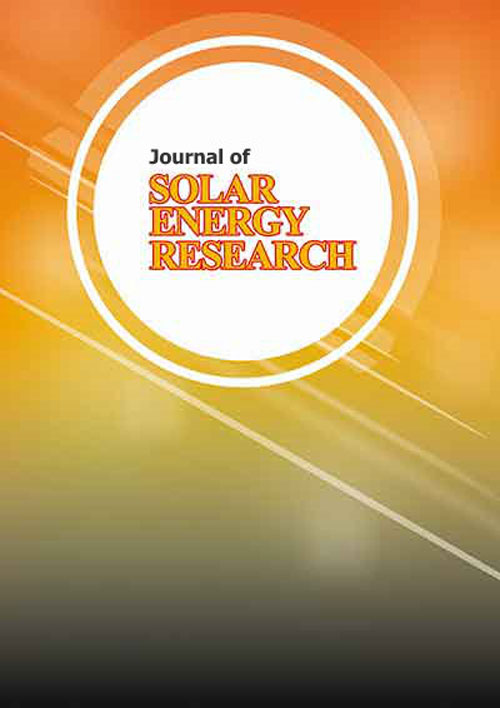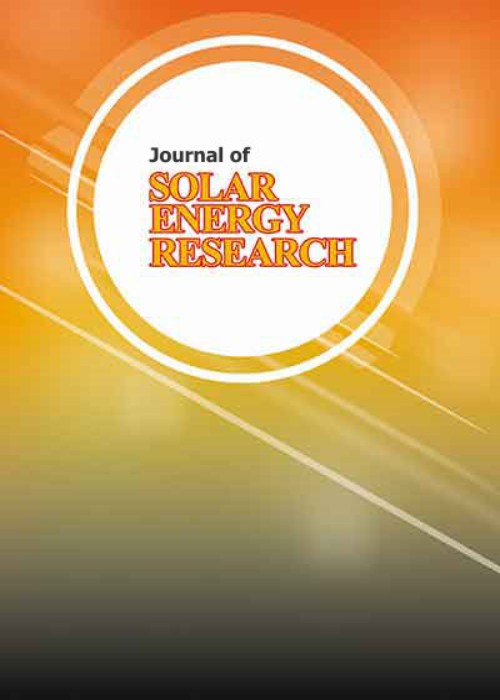فهرست مطالب

Journal of Solar Energy Research
Volume:7 Issue: 2, Spring 2022
- تاریخ انتشار: 1401/05/01
- تعداد عناوین: 6
-
-
Pages 1016-1026The utilization of nanofluids as heat transfer fluid is an effective way to increase the efficiency of solar collectors. In this research, the performance of a circular flat-panel solar collector with spiral coolant passage projected from the periphery to the center of the circle, which is like a sunflower, has been studied experimentally according to the ASHRAE standard in Aghajari (latitude 300 69/ 8// N, longitude 490 82/ 40// E) in southern Iran. Pure water and silver-water nanofluid in three mass concentrations of 0.1%, 0.2% and 0.3% have been used for evaluating collector thermal efficiency in different conditions. The results show that compared to pure water, silver-water nanofluid has a better performance and increasing silver nanoparticles from 0.1% to 0.3% improves the collector thermal efficiency by around 5.7%. Also, the efficiency of the collector becomes higher after increasing solar irradiation. In addition, it is observed that there is no relationship between air humidity and efficiency. The highest efficiency obtained from this collector at a volume fraction of 0.3% and coolant flow rate of 2.268 lit/min was about 80.3%, which is14.8% more than that of pure water.Keywords: Solar collector, Circular flat-plate, Silver-water nanofluid, Efficiency, Experimental Test
-
Pages 1027-1036This paper proposes a new non-isolated single switch boost DC-DC converter for high voltage applications. The proposed converter combines the conventional boost converter with two inductor-capacitor-diode (L-C-D) cells and achieves non-inverting high voltage gain without using a high duty cycle. Additionally, the proposed topology presents a continuous input current that makes it suitable for renewable energy applications, such as photovoltaic systems. The absence of a transformer, using devices with low voltage rating, low voltage stress across the semiconductors, no voltage spike on the switches, and common ground between source and load terminals are advantages of the proposed converter. The principles of the operation in three different modes are analyzed. In addition, the design considerations for the proposed converter are discussed. The main parameters of the converter like the voltage gain and the voltage stress on the diodes and switches are calculated and then compared with other solutions introduced in previous works. Finally, a 400W/200V experimental prototype is designed and experimentally tested. The experimental results demonstrate the effectiveness of the proposed converter.Keywords: Boost dc-dc converter, High voltage gain, Low voltage stress, Photovoltaic
-
Pages 1037-1046Silkworm cocoons are a natural biological and composite structure that has evolved over time and responds well to the environmental conditions for silkworms. Understanding the relationships of cocoon structure inspires the creation of materials such as low-weight, high-strength non-woven bio composites. In this study, the descriptive-analytical method and logical reasoning, using sericin cocoon and natural fibers, which for various reasons such as lightness, non-pollution, and low-cost, can be a suitable alternative to artificial fibers, offer materials as a non-woven bio composite. These materials are suitable in terms of stability and energy consumption, can be used as thermal insulation. This performance is simulated for the hot and dry climate of Kashan city in the outer shell of the building and using the HanyBee energy analysis plugin in the Grasshopper environment. The results show that the proposed non-woven bio composite can help improve the thermal performance of the building by up to 12.7%.Keywords: Bio mimicry, Silkworm cocoon, Bio composite with natural fibres, Bionic architectural
-
Pages 1047-1055
Nowadays, the environmental crisis, due to the combustion of fossil fuels in thermal power plants has become a global issue. Application of renewable energies is the best strategy to overcome the crisis. The photovoltaic power plants are the most popular alternative for governments. As temperature rises in PV cells, a significant drop in their produced power is observed. Therefore, it is important to lower the cell temperature with an appropriate cooling method. In this paper, three types of cooling fluids; pure water, pure Ethylene-Glycol (EG) and mixture of water/EG with the same ratio, are experimentally investigated. Based on the results, application of pure water in the PVT system, shows better performance than other two fluids. While the conventional PV module has shown the surface temperature of higher than 70 ˚C, the proposed PV modules integrated with pure water, pure EG and water + EG have shown surface temperatures of 32.7 ˚C, 36.6 ˚C and 33.7 ˚C, respectively. The maximum temperature reduction of 37.3 ˚C compared to conventional PV module, increased the output power up to 51%. Accordingly, if conventional PV modules are used for commissioning a nominal 20 kW PV power plant, only 11.7 kW is attained, whereas, water cooled PV modules can improve the output power up to 17.7 kW.
Keywords: Photovoltaic, renewable energy, PVT, ENERGY ANALYSIS, Environmental Evaluation -
Pages 1056-1066In this paper, a high step-up DC-DC converter is proposed for use in photovoltaic systems. In the proposed converter, the interleaving technique is used to reduce the input current ripple. To increase the output voltage gain, a combination of two voltage multipliers is used in the middle part of the converter. Also, because of the low voltage stress of the switches and diodes in the proposed converter, switches with lower conduction resistance and diodes with lower voltage drop can be used to construct the proposed converter to increase the efficiency of the converter. To confirm the operation of the proposed converter, the simulation results with MATLAB software are presented in this paper. A simulated version of the proposed converter can increase the input voltage below about 20 volts to a voltage level of 400 volts. The low voltage stress on semiconductor elements, high voltage gain, and low input current ripple are the critical features of the proposed converter.Keywords: DC, DC converter, Voltage multiplier, Current ripple, Interleaved converter
-
Pages 1067-1072
Solar energy is the fastest growing energy source in renewable forms, the development of solar power brings many economic and social benefits. To avoid negative impacts when connecting to the grid, it is necessary to identify and evaluate the potential and impact of rooftop solar power projects. In this study, the potential and impact of the rooftop solar power project was determined by Tra Vinh University by analytical methods and by application of specialized simulation software. The research results show that the real and simulated two-phase project with a total capacity of 300 kWp has a very high feasibility with the percentage difference in output between the simulated data and the data. actual phase I and phase II are 1.5% and 2.45% respectively. Project with total investment capital for phase I is 140,441$ and phase II is 226,483$, after 11.6 years simple payback for phase I and 9.6 years simple payback for phase II, with an output of 146,590 kW/year and 285,560 kW/year, respectively. The greenhouse gas emission limit is 4,634.2 t.CO2 over the 25-year operating life.
Keywords: Renewable energy, Solar energy, Tra Vinh University, PVSystem software


